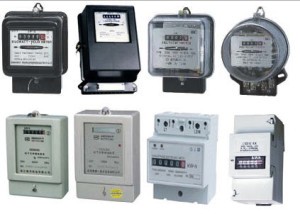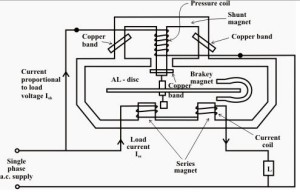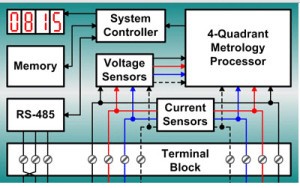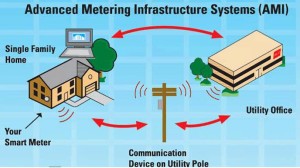Watt hour meter or energy meter is an instrument which measures amount of electrical energy used by the consumers. Utilities install these instruments at every place like homes, industries, organizations to charge the electricity consumption by loads such as lights, fans and other appliances. Most interesting type are used as prepaid electricity meters.
Basic unit of power is watts. One thousand watts is one kilowatt. If we use one kilowatt in one hour, it is considered as one unit of energy consumed. These meters measure the instantaneous voltage and currents, calculate its product and gives instantaneous power. This power is integrated over a period which gives the energy utilized over that time period.

Types of energy Meter
These may be single or three phase meters depending on the supply utilized by domestic or commercial installations. For small service measurements like domestic customers, these can be directly connected between line and load. But for larger loads, step down current transformers must be placed to isolate energy meters from higher currents.
3 Basic types of Energy meters
Energy meter or watt hour meter is classified in accordance with several factors such as:
- Type of display like analog or digital electric meter.
- Type of metering point like grid, secondary transmission, primary and local distribution.
- End applications like domestic, commercial and industrial.
- Technical like three phases, single phase, HT, LT and accuracy class meters.
1. Electromechanical induction type Energy meter

Induction type Energy meter
It is the popularly known and most common type of age old watt hour meter. It consists of rotating aluminum disc mounted on a spindle between two electro magnets. Speed of rotation of disc is proportional to the power and this power is integrated by the use of counter mechanism and gear trains. It comprises of two silicon steel laminated electromagnets i.e., series and shunt magnets.
Series magnet carries a coil which is of few turns of thick wire connected in series with line whereas shunt magnet carries coil with many turns of thin wire connected across the supply.
Breaking magnet is a permanent magnet which applies the force opposite to normal disc rotation to move that disc at balanced position and to stop the disc while power is off.

Working of induction type energy meter
Series magnet produces the flux which is proportional to the current flowing and shunt magnet produces the flux proportional to the voltage. These two fluxes lag by 90 degrees due to inductive nature. The interaction of these two fields produces eddy current in the disk, exerting a force, which is proportional to product of instantaneous voltage, current and phase angle between them.
Vertical spindle or shaft of the aluminum disc is connected to gear arrangement which records a number, proportional to the number of revolutions of the disc. This gear arrangement sets the number in a series of dials and indicates energy consumed over a time. This type of meter is simple in construction and accuracy is somewhat less due to creeping and other external fields. A major problem with these types of meters is their easy prone to tampering, leading to a requirement of an electrical energy monitoring system. These are very commonly used in domestic and industrial applications.
2. Electronic Energy meters
These are of accurate, high procession and reliable types of measuring instruments as compared to conventional mechanical meters. It consumes less power and starts measuring instantaneously when connected to load. These meters might be analog or digital. In analog meters, power is converted to proportional frequency or pulse rate and it is integrated by counters placed inside it. In digital electric meter power is directly measured by high end processor. The power is integrated by logic circuits to get the energy and also for testing and calibration purpose. It is then converted to frequency or pulse rate.
Analog Electronic Energy Meters
In analog type meters, voltage and current values of each phase are obtained by voltage divider and current transformers respectively which are directly connected to the load as shown in figure.

Analog Electronic Meters
Analog to digital converter converts these analog values to digitized samples and it is then converted to corresponding frequency signals by frequency converter. These frequency pulses then drive a counter mechanism where these samples are integrated over a time to produce the electricity consumption.
Digital Electronic Energy Meters
Digital signal processor or high performance microprocessors are used in digital electric meters. Similar to the analog meters, voltage and current transducers are connected to a high resolution ADC. Once it converts analog signals to digital samples, voltage and current samples are multiplied and integrated by digital circuits to measure the energy consumed.

Digital Electronic Energy Meters
Microprocessor also calculates phase angle between voltage and current, so that it also measures and indicates reactive power. It is programmed in such a way that it calculates energy according to the tariff and other parameters like power factor, maximum demand, etc and stores all these values in a non volatile memory EEPROM.
It contains real time clock (RTC) for calculating time for power integration, maximum demand calculations and also date and time stamps for particular parameters. Furthermore it interacts with liquid crystal display (LCD), communication devices and other meter outputs. Battery is provided for RTC and other significant peripherals for backup power.
3. Smart Energy Meters
It is an advanced metering technology involving placing intelligent meters to read, process and feedback the data to customers. It measures energy consumption, remotely switches the supply to customers and remotely controls the maximum electricity consumption. Smart metering system uses the advanced metering infrastructure system technology for better performance.

Smart Energy Meters
These are capable of communicating in both directions. They can transmit the data to the utilities like energy consumption, parameter values, alarms, etc and also can receive information from utilities such as automatic meter reading system, reconnect/disconnect instructions, upgrading of meter software’s and other important messages. These meters reduce the need to visit while taking or reading monthly bill. Modems are used in these smart meters to facilitate communication systems such as telephone, wireless, fiber cable, power line communications. Another advantage of smart metering is complete avoidance of tampering of energy meter where there is scope of using power in an illegal way.
Please refer to this link to know more about Energy Meter MCQs.
This is all about types of energy meter and their working. Hope you are satisfied with this article. We express our gratitude to all the readers. Please share your comments and suggestions on the comment section given below.
Photo credits
- Types of Energy meters by psiindia
- Induction type Energy meter by asia.ru
- Working of induction type energy meter by electrical-engineering-portal
- Analog electronic energy meters by analog
- Structure of smart metering by aeptexas